Policy for Advocacy: Diabetes in Developing Asian Countries
VerifiedAdded on 2022/12/30
|13
|3891
|1
Report
AI Summary
This report presents a policy for advocacy addressing the critical issue of diabetes, particularly focusing on developing countries in Asia. It begins by introducing the World Diabetes Foundation (WDF) and the significance of awareness and research in managing the disease. The report outlines the health issue, highlighting the multiple organ systems affected by diabetes and its various complications, as well as the rise in the disease in Asian populations. It then emphasizes the importance of disease prevention, including screening programs. The policy's aims and objectives include reducing healthcare costs, improving resource availability, and incorporating innovative design approaches in healthcare systems. The report provides evidence of the urgency of the issue, citing the higher genetic predisposition of Asians and the lack of basic infrastructure in developing countries. Finally, it recommends government actions such as taxation on sugary drinks and awareness programs to combat the disease. The report emphasizes the need for cost reduction to make healthcare accessible to all and includes various factors that contribute to the disease, along with recommendations to mitigate its effects.
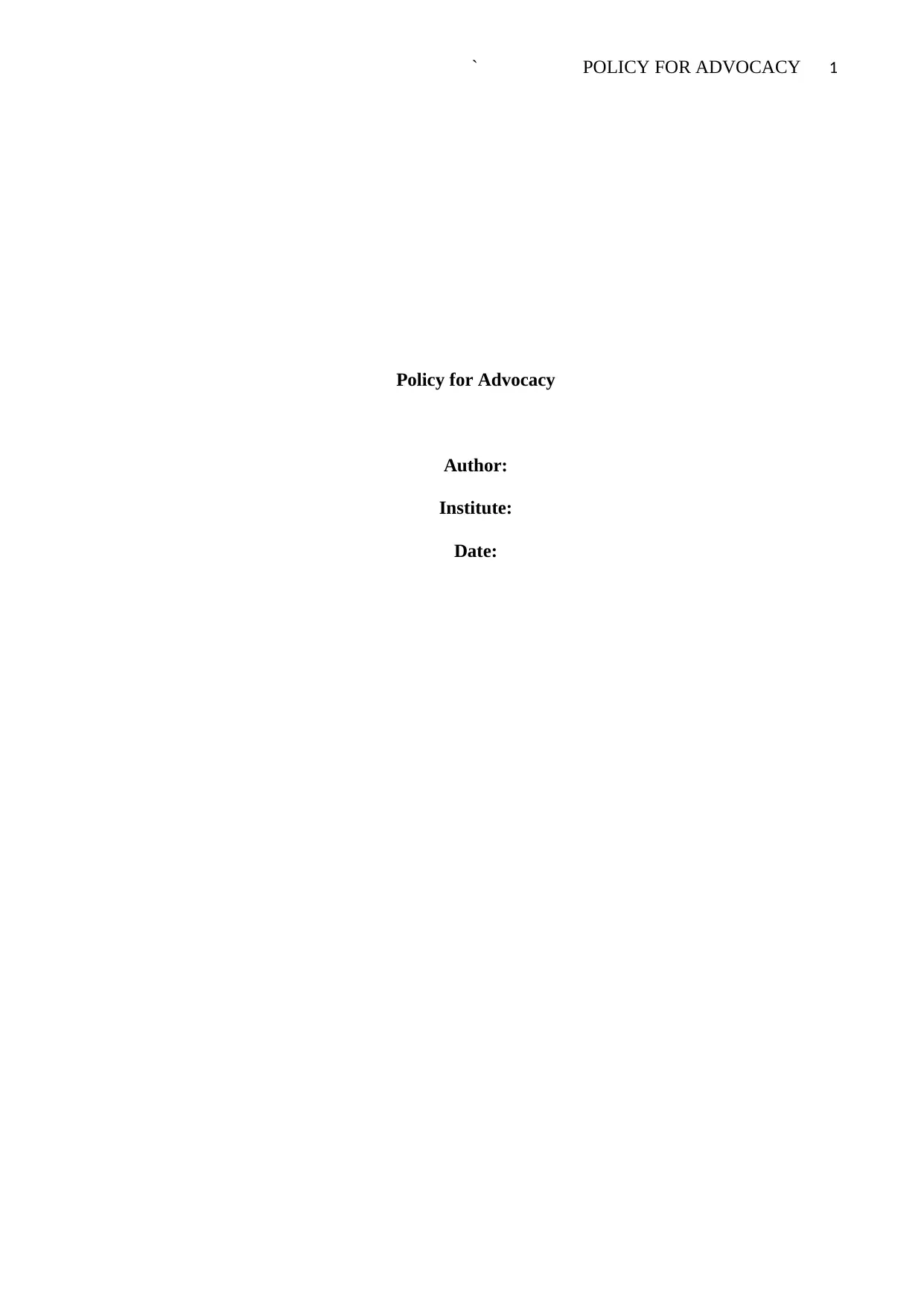
` POLICY FOR ADVOCACY 1
Policy for Advocacy
Author:
Institute:
Date:
Policy for Advocacy
Author:
Institute:
Date:
Paraphrase This Document
Need a fresh take? Get an instant paraphrase of this document with our AI Paraphraser
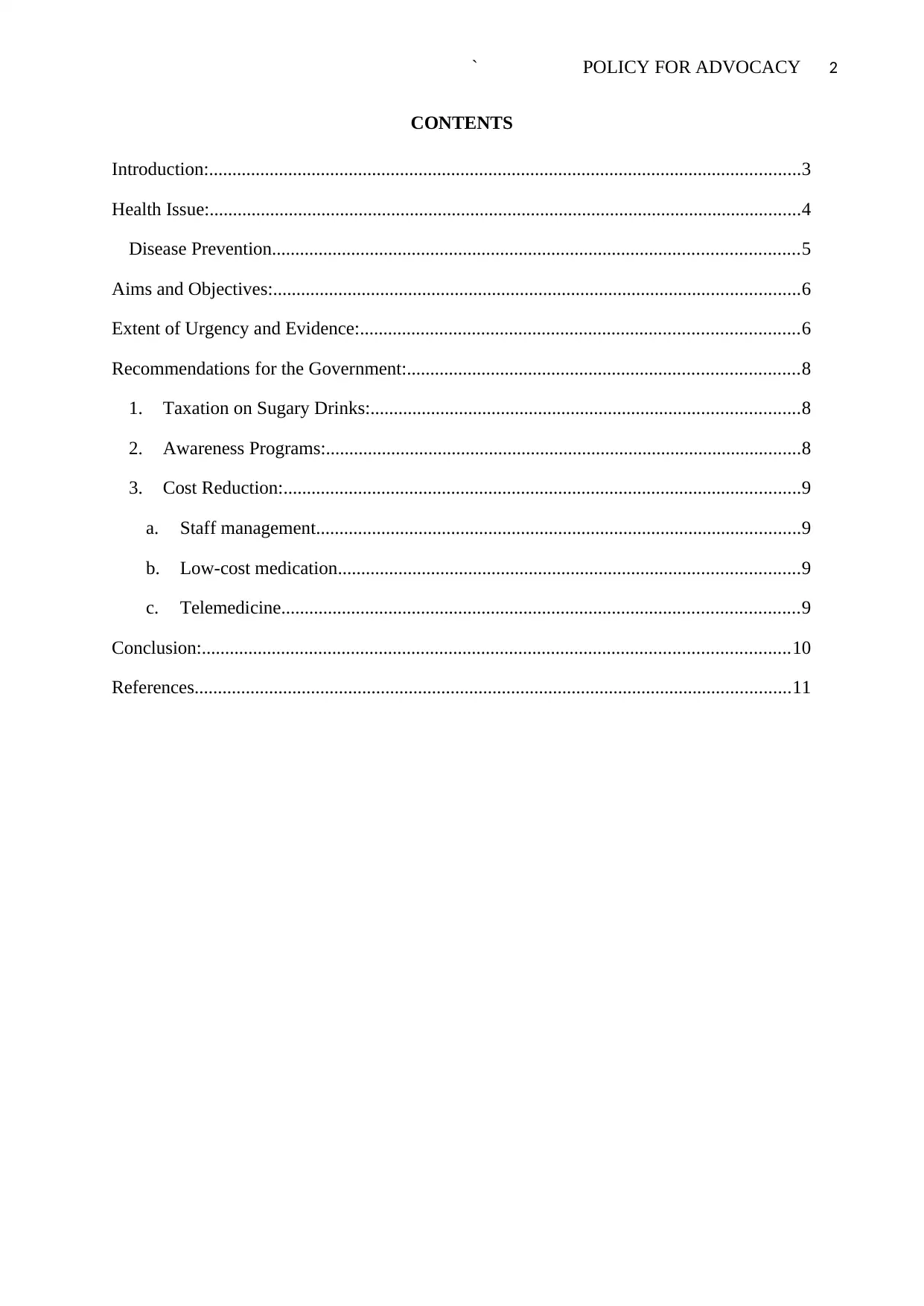
` POLICY FOR ADVOCACY 2
CONTENTS
Introduction:...............................................................................................................................3
Health Issue:...............................................................................................................................4
Disease Prevention.................................................................................................................5
Aims and Objectives:.................................................................................................................6
Extent of Urgency and Evidence:..............................................................................................6
Recommendations for the Government:....................................................................................8
1. Taxation on Sugary Drinks:............................................................................................8
2. Awareness Programs:......................................................................................................8
3. Cost Reduction:...............................................................................................................9
a. Staff management........................................................................................................9
b. Low-cost medication...................................................................................................9
c. Telemedicine...............................................................................................................9
Conclusion:..............................................................................................................................10
References................................................................................................................................11
CONTENTS
Introduction:...............................................................................................................................3
Health Issue:...............................................................................................................................4
Disease Prevention.................................................................................................................5
Aims and Objectives:.................................................................................................................6
Extent of Urgency and Evidence:..............................................................................................6
Recommendations for the Government:....................................................................................8
1. Taxation on Sugary Drinks:............................................................................................8
2. Awareness Programs:......................................................................................................8
3. Cost Reduction:...............................................................................................................9
a. Staff management........................................................................................................9
b. Low-cost medication...................................................................................................9
c. Telemedicine...............................................................................................................9
Conclusion:..............................................................................................................................10
References................................................................................................................................11
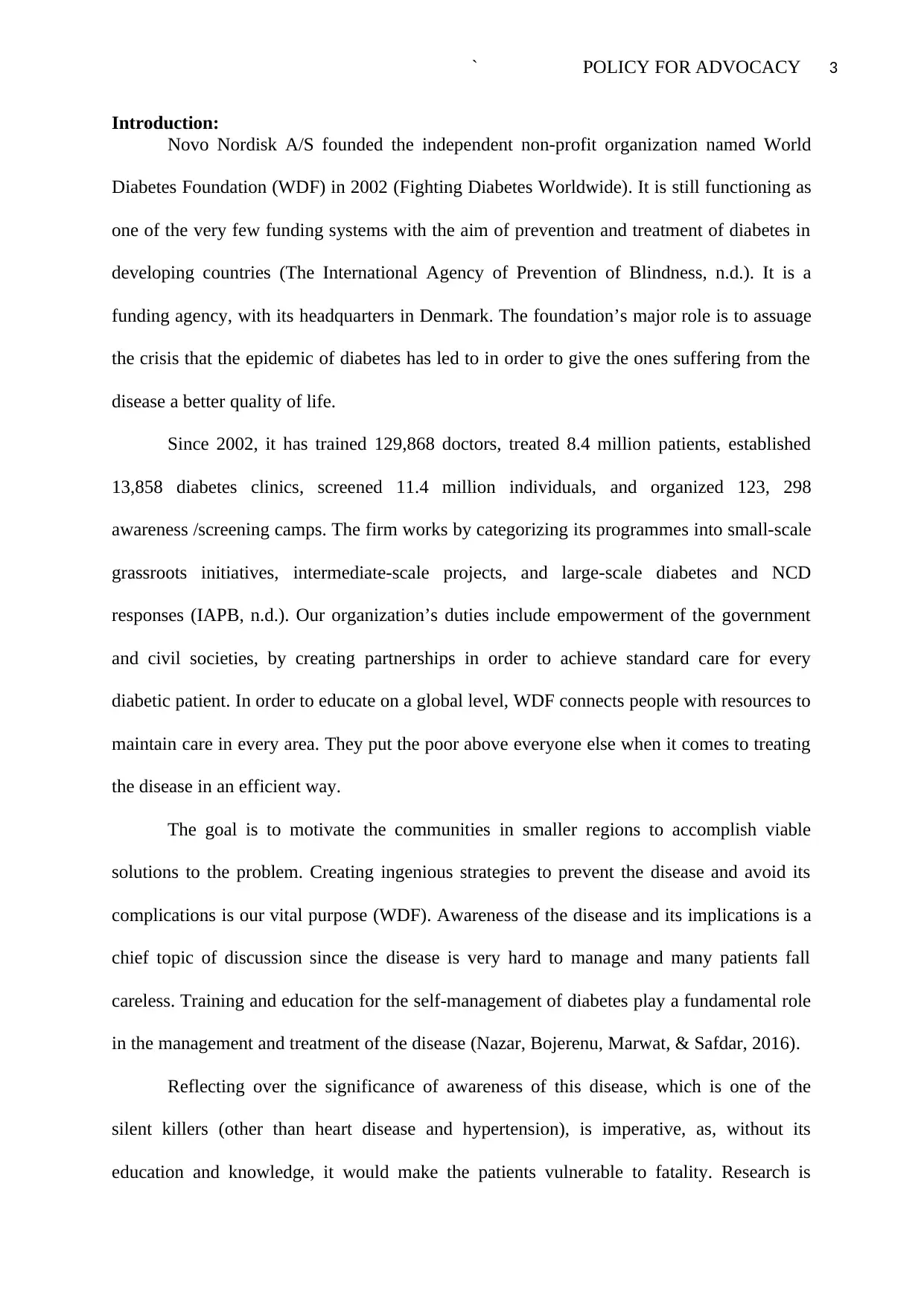
` POLICY FOR ADVOCACY 3
Introduction:
Novo Nordisk A/S founded the independent non-profit organization named World
Diabetes Foundation (WDF) in 2002 (Fighting Diabetes Worldwide). It is still functioning as
one of the very few funding systems with the aim of prevention and treatment of diabetes in
developing countries (The International Agency of Prevention of Blindness, n.d.). It is a
funding agency, with its headquarters in Denmark. The foundation’s major role is to assuage
the crisis that the epidemic of diabetes has led to in order to give the ones suffering from the
disease a better quality of life.
Since 2002, it has trained 129,868 doctors, treated 8.4 million patients, established
13,858 diabetes clinics, screened 11.4 million individuals, and organized 123, 298
awareness /screening camps. The firm works by categorizing its programmes into small-scale
grassroots initiatives, intermediate-scale projects, and large-scale diabetes and NCD
responses (IAPB, n.d.). Our organization’s duties include empowerment of the government
and civil societies, by creating partnerships in order to achieve standard care for every
diabetic patient. In order to educate on a global level, WDF connects people with resources to
maintain care in every area. They put the poor above everyone else when it comes to treating
the disease in an efficient way.
The goal is to motivate the communities in smaller regions to accomplish viable
solutions to the problem. Creating ingenious strategies to prevent the disease and avoid its
complications is our vital purpose (WDF). Awareness of the disease and its implications is a
chief topic of discussion since the disease is very hard to manage and many patients fall
careless. Training and education for the self-management of diabetes play a fundamental role
in the management and treatment of the disease (Nazar, Bojerenu, Marwat, & Safdar, 2016).
Reflecting over the significance of awareness of this disease, which is one of the
silent killers (other than heart disease and hypertension), is imperative, as, without its
education and knowledge, it would make the patients vulnerable to fatality. Research is
Introduction:
Novo Nordisk A/S founded the independent non-profit organization named World
Diabetes Foundation (WDF) in 2002 (Fighting Diabetes Worldwide). It is still functioning as
one of the very few funding systems with the aim of prevention and treatment of diabetes in
developing countries (The International Agency of Prevention of Blindness, n.d.). It is a
funding agency, with its headquarters in Denmark. The foundation’s major role is to assuage
the crisis that the epidemic of diabetes has led to in order to give the ones suffering from the
disease a better quality of life.
Since 2002, it has trained 129,868 doctors, treated 8.4 million patients, established
13,858 diabetes clinics, screened 11.4 million individuals, and organized 123, 298
awareness /screening camps. The firm works by categorizing its programmes into small-scale
grassroots initiatives, intermediate-scale projects, and large-scale diabetes and NCD
responses (IAPB, n.d.). Our organization’s duties include empowerment of the government
and civil societies, by creating partnerships in order to achieve standard care for every
diabetic patient. In order to educate on a global level, WDF connects people with resources to
maintain care in every area. They put the poor above everyone else when it comes to treating
the disease in an efficient way.
The goal is to motivate the communities in smaller regions to accomplish viable
solutions to the problem. Creating ingenious strategies to prevent the disease and avoid its
complications is our vital purpose (WDF). Awareness of the disease and its implications is a
chief topic of discussion since the disease is very hard to manage and many patients fall
careless. Training and education for the self-management of diabetes play a fundamental role
in the management and treatment of the disease (Nazar, Bojerenu, Marwat, & Safdar, 2016).
Reflecting over the significance of awareness of this disease, which is one of the
silent killers (other than heart disease and hypertension), is imperative, as, without its
education and knowledge, it would make the patients vulnerable to fatality. Research is
⊘ This is a preview!⊘
Do you want full access?
Subscribe today to unlock all pages.

Trusted by 1+ million students worldwide
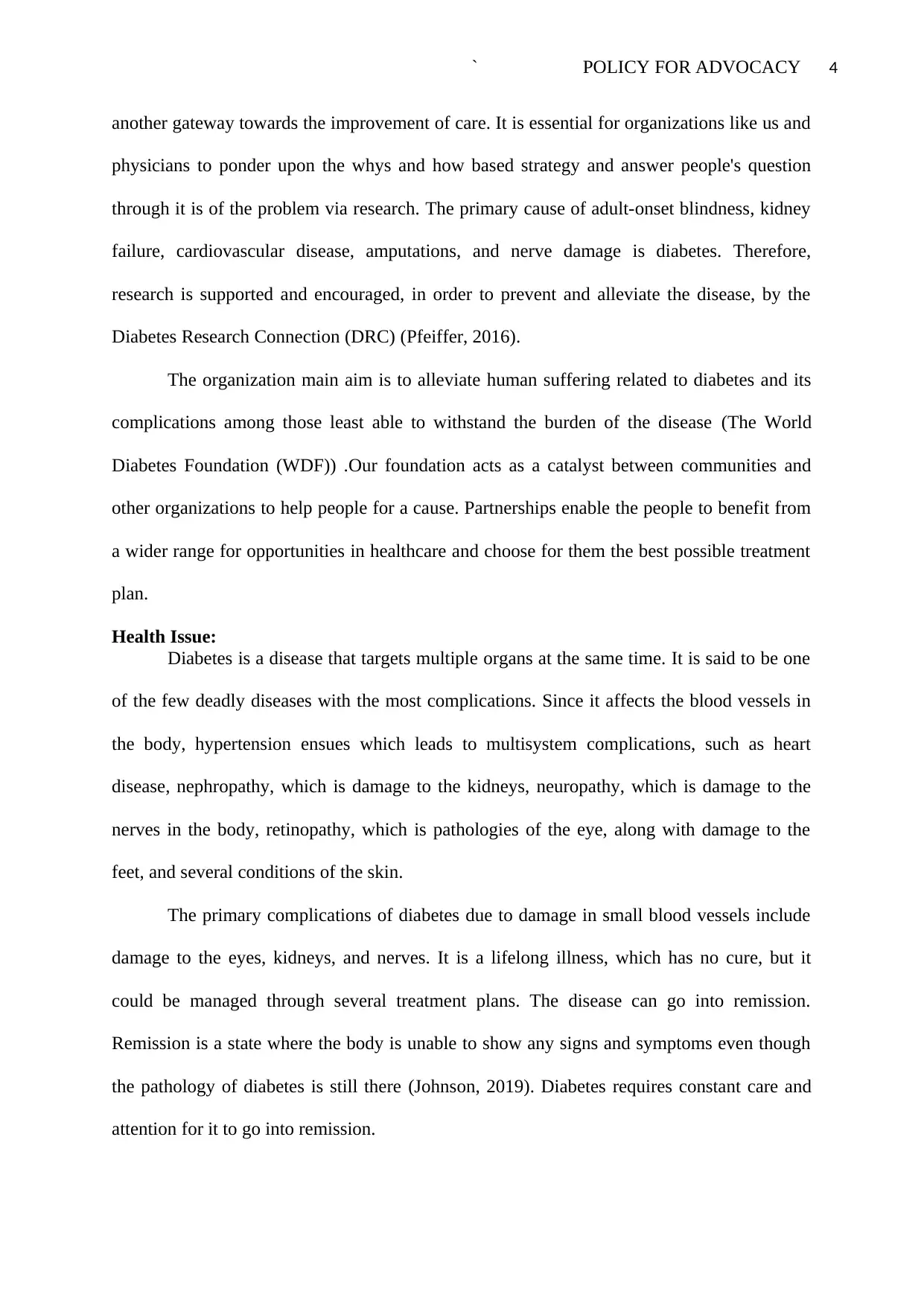
` POLICY FOR ADVOCACY 4
another gateway towards the improvement of care. It is essential for organizations like us and
physicians to ponder upon the whys and how based strategy and answer people's question
through it is of the problem via research. The primary cause of adult-onset blindness, kidney
failure, cardiovascular disease, amputations, and nerve damage is diabetes. Therefore,
research is supported and encouraged, in order to prevent and alleviate the disease, by the
Diabetes Research Connection (DRC) (Pfeiffer, 2016).
The organization main aim is to alleviate human suffering related to diabetes and its
complications among those least able to withstand the burden of the disease (The World
Diabetes Foundation (WDF)) .Our foundation acts as a catalyst between communities and
other organizations to help people for a cause. Partnerships enable the people to benefit from
a wider range for opportunities in healthcare and choose for them the best possible treatment
plan.
Health Issue:
Diabetes is a disease that targets multiple organs at the same time. It is said to be one
of the few deadly diseases with the most complications. Since it affects the blood vessels in
the body, hypertension ensues which leads to multisystem complications, such as heart
disease, nephropathy, which is damage to the kidneys, neuropathy, which is damage to the
nerves in the body, retinopathy, which is pathologies of the eye, along with damage to the
feet, and several conditions of the skin.
The primary complications of diabetes due to damage in small blood vessels include
damage to the eyes, kidneys, and nerves. It is a lifelong illness, which has no cure, but it
could be managed through several treatment plans. The disease can go into remission.
Remission is a state where the body is unable to show any signs and symptoms even though
the pathology of diabetes is still there (Johnson, 2019). Diabetes requires constant care and
attention for it to go into remission.
another gateway towards the improvement of care. It is essential for organizations like us and
physicians to ponder upon the whys and how based strategy and answer people's question
through it is of the problem via research. The primary cause of adult-onset blindness, kidney
failure, cardiovascular disease, amputations, and nerve damage is diabetes. Therefore,
research is supported and encouraged, in order to prevent and alleviate the disease, by the
Diabetes Research Connection (DRC) (Pfeiffer, 2016).
The organization main aim is to alleviate human suffering related to diabetes and its
complications among those least able to withstand the burden of the disease (The World
Diabetes Foundation (WDF)) .Our foundation acts as a catalyst between communities and
other organizations to help people for a cause. Partnerships enable the people to benefit from
a wider range for opportunities in healthcare and choose for them the best possible treatment
plan.
Health Issue:
Diabetes is a disease that targets multiple organs at the same time. It is said to be one
of the few deadly diseases with the most complications. Since it affects the blood vessels in
the body, hypertension ensues which leads to multisystem complications, such as heart
disease, nephropathy, which is damage to the kidneys, neuropathy, which is damage to the
nerves in the body, retinopathy, which is pathologies of the eye, along with damage to the
feet, and several conditions of the skin.
The primary complications of diabetes due to damage in small blood vessels include
damage to the eyes, kidneys, and nerves. It is a lifelong illness, which has no cure, but it
could be managed through several treatment plans. The disease can go into remission.
Remission is a state where the body is unable to show any signs and symptoms even though
the pathology of diabetes is still there (Johnson, 2019). Diabetes requires constant care and
attention for it to go into remission.
Paraphrase This Document
Need a fresh take? Get an instant paraphrase of this document with our AI Paraphraser
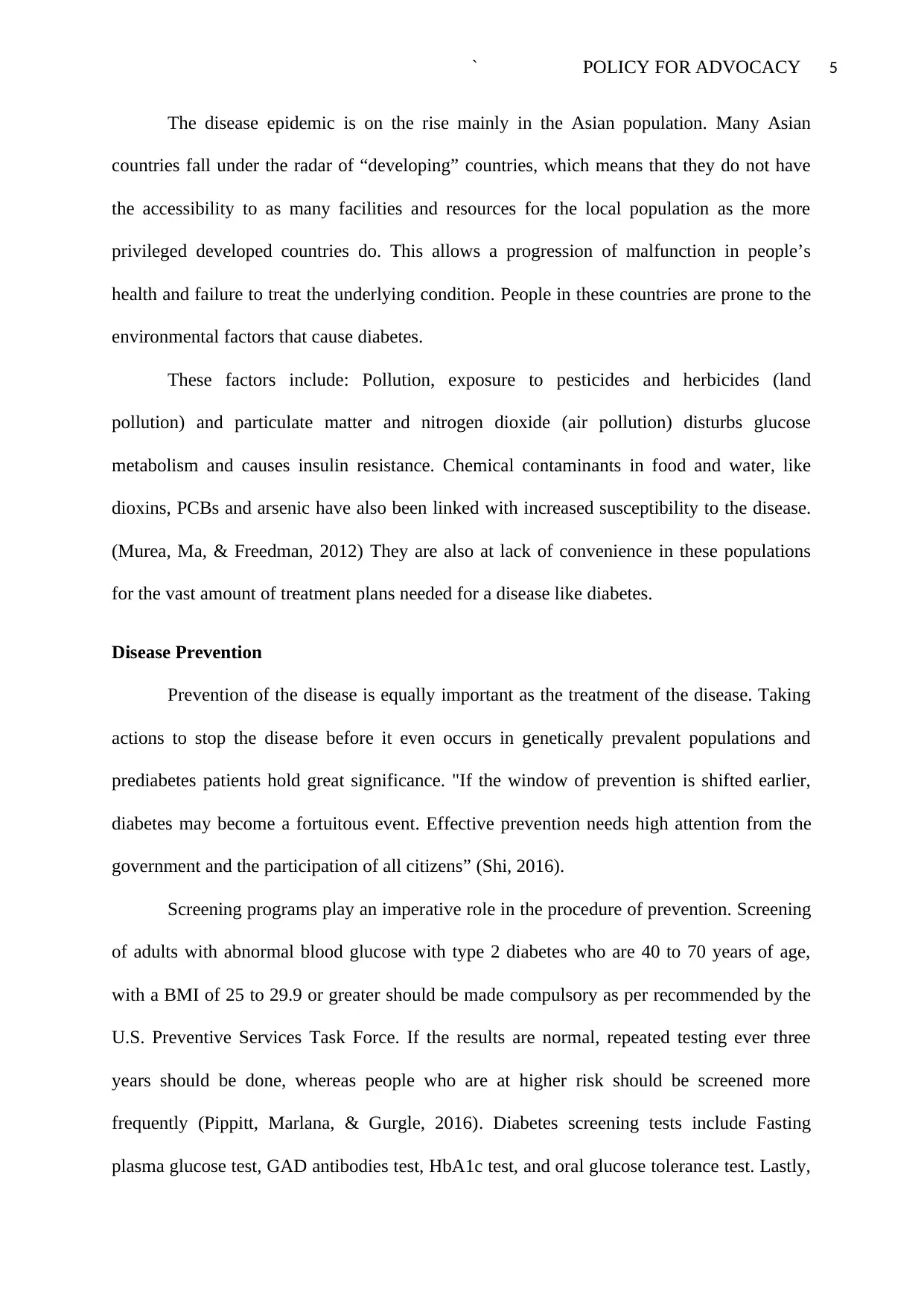
` POLICY FOR ADVOCACY 5
The disease epidemic is on the rise mainly in the Asian population. Many Asian
countries fall under the radar of “developing” countries, which means that they do not have
the accessibility to as many facilities and resources for the local population as the more
privileged developed countries do. This allows a progression of malfunction in people’s
health and failure to treat the underlying condition. People in these countries are prone to the
environmental factors that cause diabetes.
These factors include: Pollution, exposure to pesticides and herbicides (land
pollution) and particulate matter and nitrogen dioxide (air pollution) disturbs glucose
metabolism and causes insulin resistance. Chemical contaminants in food and water, like
dioxins, PCBs and arsenic have also been linked with increased susceptibility to the disease.
(Murea, Ma, & Freedman, 2012) They are also at lack of convenience in these populations
for the vast amount of treatment plans needed for a disease like diabetes.
Disease Prevention
Prevention of the disease is equally important as the treatment of the disease. Taking
actions to stop the disease before it even occurs in genetically prevalent populations and
prediabetes patients hold great significance. "If the window of prevention is shifted earlier,
diabetes may become a fortuitous event. Effective prevention needs high attention from the
government and the participation of all citizens” (Shi, 2016).
Screening programs play an imperative role in the procedure of prevention. Screening
of adults with abnormal blood glucose with type 2 diabetes who are 40 to 70 years of age,
with a BMI of 25 to 29.9 or greater should be made compulsory as per recommended by the
U.S. Preventive Services Task Force. If the results are normal, repeated testing ever three
years should be done, whereas people who are at higher risk should be screened more
frequently (Pippitt, Marlana, & Gurgle, 2016). Diabetes screening tests include Fasting
plasma glucose test, GAD antibodies test, HbA1c test, and oral glucose tolerance test. Lastly,
The disease epidemic is on the rise mainly in the Asian population. Many Asian
countries fall under the radar of “developing” countries, which means that they do not have
the accessibility to as many facilities and resources for the local population as the more
privileged developed countries do. This allows a progression of malfunction in people’s
health and failure to treat the underlying condition. People in these countries are prone to the
environmental factors that cause diabetes.
These factors include: Pollution, exposure to pesticides and herbicides (land
pollution) and particulate matter and nitrogen dioxide (air pollution) disturbs glucose
metabolism and causes insulin resistance. Chemical contaminants in food and water, like
dioxins, PCBs and arsenic have also been linked with increased susceptibility to the disease.
(Murea, Ma, & Freedman, 2012) They are also at lack of convenience in these populations
for the vast amount of treatment plans needed for a disease like diabetes.
Disease Prevention
Prevention of the disease is equally important as the treatment of the disease. Taking
actions to stop the disease before it even occurs in genetically prevalent populations and
prediabetes patients hold great significance. "If the window of prevention is shifted earlier,
diabetes may become a fortuitous event. Effective prevention needs high attention from the
government and the participation of all citizens” (Shi, 2016).
Screening programs play an imperative role in the procedure of prevention. Screening
of adults with abnormal blood glucose with type 2 diabetes who are 40 to 70 years of age,
with a BMI of 25 to 29.9 or greater should be made compulsory as per recommended by the
U.S. Preventive Services Task Force. If the results are normal, repeated testing ever three
years should be done, whereas people who are at higher risk should be screened more
frequently (Pippitt, Marlana, & Gurgle, 2016). Diabetes screening tests include Fasting
plasma glucose test, GAD antibodies test, HbA1c test, and oral glucose tolerance test. Lastly,
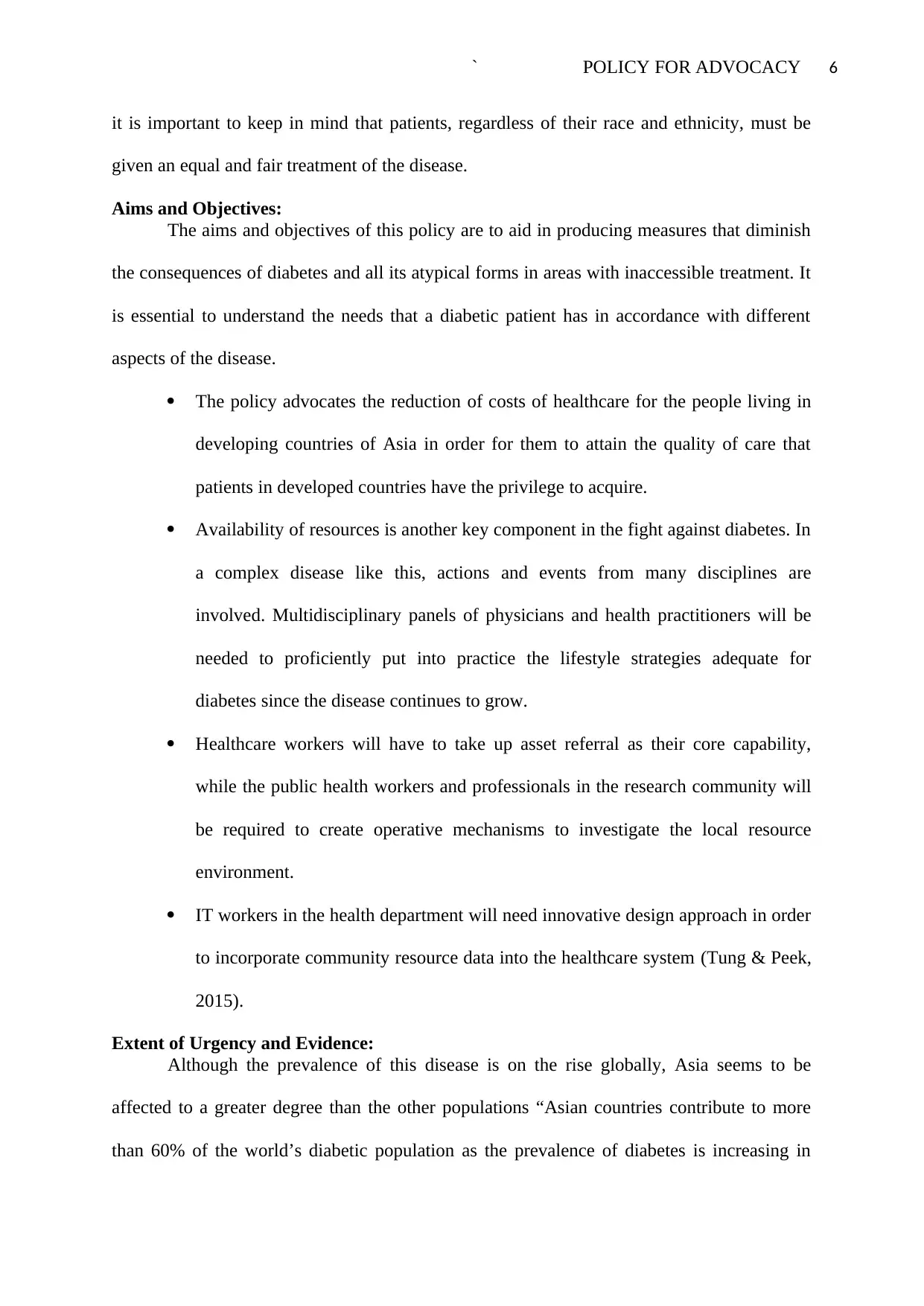
` POLICY FOR ADVOCACY 6
it is important to keep in mind that patients, regardless of their race and ethnicity, must be
given an equal and fair treatment of the disease.
Aims and Objectives:
The aims and objectives of this policy are to aid in producing measures that diminish
the consequences of diabetes and all its atypical forms in areas with inaccessible treatment. It
is essential to understand the needs that a diabetic patient has in accordance with different
aspects of the disease.
The policy advocates the reduction of costs of healthcare for the people living in
developing countries of Asia in order for them to attain the quality of care that
patients in developed countries have the privilege to acquire.
Availability of resources is another key component in the fight against diabetes. In
a complex disease like this, actions and events from many disciplines are
involved. Multidisciplinary panels of physicians and health practitioners will be
needed to proficiently put into practice the lifestyle strategies adequate for
diabetes since the disease continues to grow.
Healthcare workers will have to take up asset referral as their core capability,
while the public health workers and professionals in the research community will
be required to create operative mechanisms to investigate the local resource
environment.
IT workers in the health department will need innovative design approach in order
to incorporate community resource data into the healthcare system (Tung & Peek,
2015).
Extent of Urgency and Evidence:
Although the prevalence of this disease is on the rise globally, Asia seems to be
affected to a greater degree than the other populations “Asian countries contribute to more
than 60% of the world’s diabetic population as the prevalence of diabetes is increasing in
it is important to keep in mind that patients, regardless of their race and ethnicity, must be
given an equal and fair treatment of the disease.
Aims and Objectives:
The aims and objectives of this policy are to aid in producing measures that diminish
the consequences of diabetes and all its atypical forms in areas with inaccessible treatment. It
is essential to understand the needs that a diabetic patient has in accordance with different
aspects of the disease.
The policy advocates the reduction of costs of healthcare for the people living in
developing countries of Asia in order for them to attain the quality of care that
patients in developed countries have the privilege to acquire.
Availability of resources is another key component in the fight against diabetes. In
a complex disease like this, actions and events from many disciplines are
involved. Multidisciplinary panels of physicians and health practitioners will be
needed to proficiently put into practice the lifestyle strategies adequate for
diabetes since the disease continues to grow.
Healthcare workers will have to take up asset referral as their core capability,
while the public health workers and professionals in the research community will
be required to create operative mechanisms to investigate the local resource
environment.
IT workers in the health department will need innovative design approach in order
to incorporate community resource data into the healthcare system (Tung & Peek,
2015).
Extent of Urgency and Evidence:
Although the prevalence of this disease is on the rise globally, Asia seems to be
affected to a greater degree than the other populations “Asian countries contribute to more
than 60% of the world’s diabetic population as the prevalence of diabetes is increasing in
⊘ This is a preview!⊘
Do you want full access?
Subscribe today to unlock all pages.

Trusted by 1+ million students worldwide
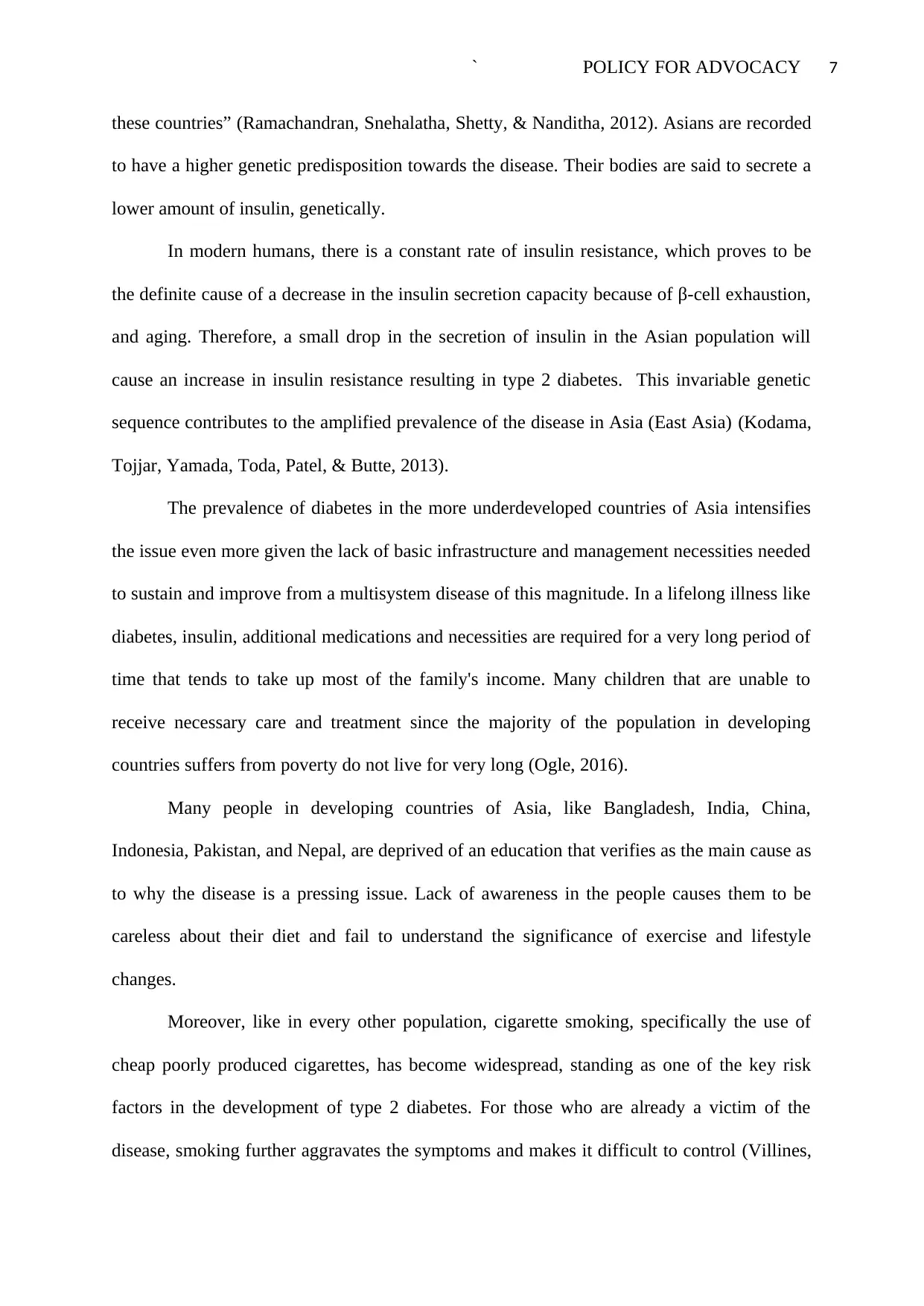
` POLICY FOR ADVOCACY 7
these countries” (Ramachandran, Snehalatha, Shetty, & Nanditha, 2012). Asians are recorded
to have a higher genetic predisposition towards the disease. Their bodies are said to secrete a
lower amount of insulin, genetically.
In modern humans, there is a constant rate of insulin resistance, which proves to be
the definite cause of a decrease in the insulin secretion capacity because of β-cell exhaustion,
and aging. Therefore, a small drop in the secretion of insulin in the Asian population will
cause an increase in insulin resistance resulting in type 2 diabetes. This invariable genetic
sequence contributes to the amplified prevalence of the disease in Asia (East Asia) (Kodama,
Tojjar, Yamada, Toda, Patel, & Butte, 2013).
The prevalence of diabetes in the more underdeveloped countries of Asia intensifies
the issue even more given the lack of basic infrastructure and management necessities needed
to sustain and improve from a multisystem disease of this magnitude. In a lifelong illness like
diabetes, insulin, additional medications and necessities are required for a very long period of
time that tends to take up most of the family's income. Many children that are unable to
receive necessary care and treatment since the majority of the population in developing
countries suffers from poverty do not live for very long (Ogle, 2016).
Many people in developing countries of Asia, like Bangladesh, India, China,
Indonesia, Pakistan, and Nepal, are deprived of an education that verifies as the main cause as
to why the disease is a pressing issue. Lack of awareness in the people causes them to be
careless about their diet and fail to understand the significance of exercise and lifestyle
changes.
Moreover, like in every other population, cigarette smoking, specifically the use of
cheap poorly produced cigarettes, has become widespread, standing as one of the key risk
factors in the development of type 2 diabetes. For those who are already a victim of the
disease, smoking further aggravates the symptoms and makes it difficult to control (Villines,
these countries” (Ramachandran, Snehalatha, Shetty, & Nanditha, 2012). Asians are recorded
to have a higher genetic predisposition towards the disease. Their bodies are said to secrete a
lower amount of insulin, genetically.
In modern humans, there is a constant rate of insulin resistance, which proves to be
the definite cause of a decrease in the insulin secretion capacity because of β-cell exhaustion,
and aging. Therefore, a small drop in the secretion of insulin in the Asian population will
cause an increase in insulin resistance resulting in type 2 diabetes. This invariable genetic
sequence contributes to the amplified prevalence of the disease in Asia (East Asia) (Kodama,
Tojjar, Yamada, Toda, Patel, & Butte, 2013).
The prevalence of diabetes in the more underdeveloped countries of Asia intensifies
the issue even more given the lack of basic infrastructure and management necessities needed
to sustain and improve from a multisystem disease of this magnitude. In a lifelong illness like
diabetes, insulin, additional medications and necessities are required for a very long period of
time that tends to take up most of the family's income. Many children that are unable to
receive necessary care and treatment since the majority of the population in developing
countries suffers from poverty do not live for very long (Ogle, 2016).
Many people in developing countries of Asia, like Bangladesh, India, China,
Indonesia, Pakistan, and Nepal, are deprived of an education that verifies as the main cause as
to why the disease is a pressing issue. Lack of awareness in the people causes them to be
careless about their diet and fail to understand the significance of exercise and lifestyle
changes.
Moreover, like in every other population, cigarette smoking, specifically the use of
cheap poorly produced cigarettes, has become widespread, standing as one of the key risk
factors in the development of type 2 diabetes. For those who are already a victim of the
disease, smoking further aggravates the symptoms and makes it difficult to control (Villines,
Paraphrase This Document
Need a fresh take? Get an instant paraphrase of this document with our AI Paraphraser
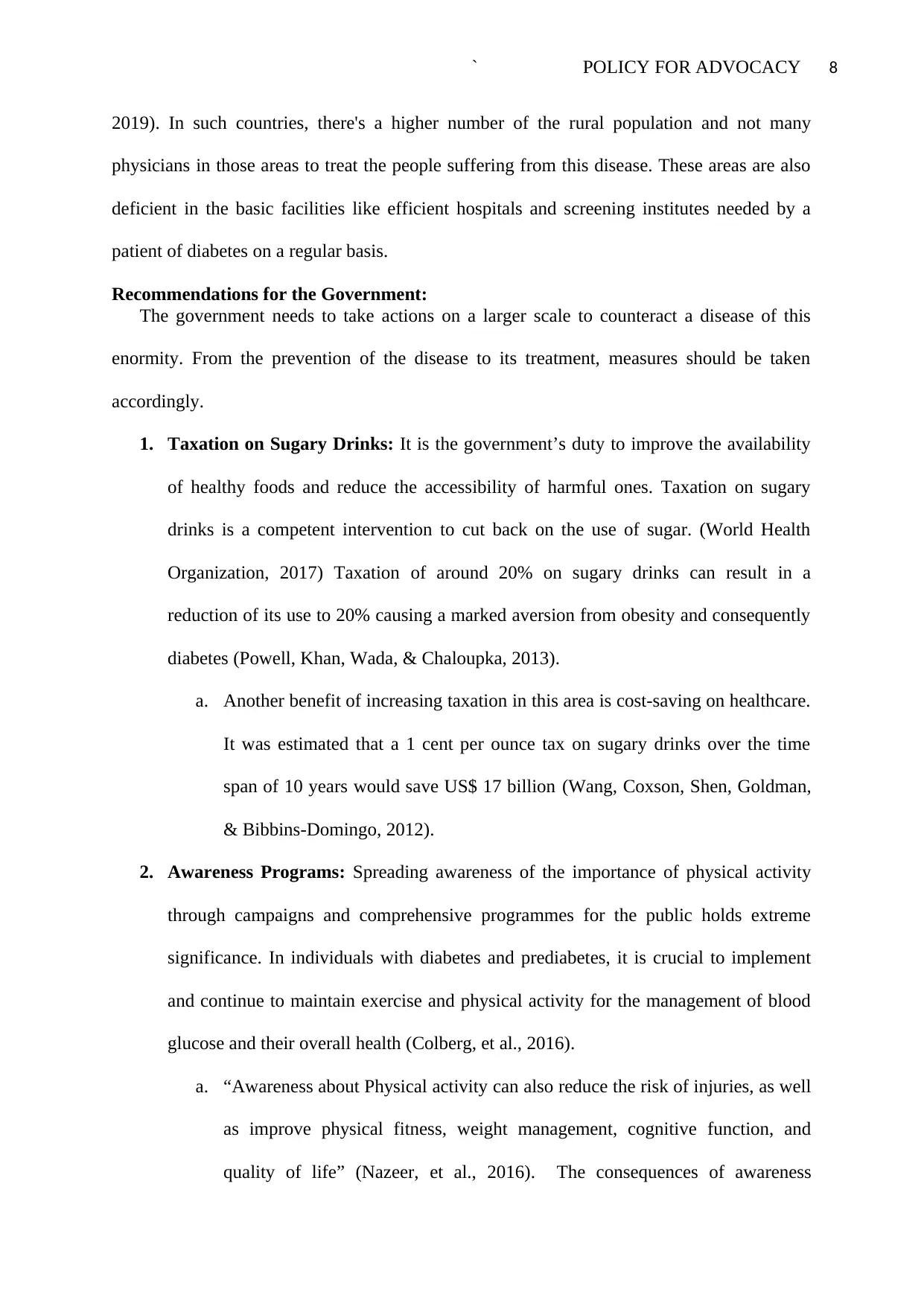
` POLICY FOR ADVOCACY 8
2019). In such countries, there's a higher number of the rural population and not many
physicians in those areas to treat the people suffering from this disease. These areas are also
deficient in the basic facilities like efficient hospitals and screening institutes needed by a
patient of diabetes on a regular basis.
Recommendations for the Government:
The government needs to take actions on a larger scale to counteract a disease of this
enormity. From the prevention of the disease to its treatment, measures should be taken
accordingly.
1. Taxation on Sugary Drinks: It is the government’s duty to improve the availability
of healthy foods and reduce the accessibility of harmful ones. Taxation on sugary
drinks is a competent intervention to cut back on the use of sugar. (World Health
Organization, 2017) Taxation of around 20% on sugary drinks can result in a
reduction of its use to 20% causing a marked aversion from obesity and consequently
diabetes (Powell, Khan, Wada, & Chaloupka, 2013).
a. Another benefit of increasing taxation in this area is cost-saving on healthcare.
It was estimated that a 1 cent per ounce tax on sugary drinks over the time
span of 10 years would save US$ 17 billion (Wang, Coxson, Shen, Goldman,
& Bibbins-Domingo, 2012).
2. Awareness Programs: Spreading awareness of the importance of physical activity
through campaigns and comprehensive programmes for the public holds extreme
significance. In individuals with diabetes and prediabetes, it is crucial to implement
and continue to maintain exercise and physical activity for the management of blood
glucose and their overall health (Colberg, et al., 2016).
a. “Awareness about Physical activity can also reduce the risk of injuries, as well
as improve physical fitness, weight management, cognitive function, and
quality of life” (Nazeer, et al., 2016). The consequences of awareness
2019). In such countries, there's a higher number of the rural population and not many
physicians in those areas to treat the people suffering from this disease. These areas are also
deficient in the basic facilities like efficient hospitals and screening institutes needed by a
patient of diabetes on a regular basis.
Recommendations for the Government:
The government needs to take actions on a larger scale to counteract a disease of this
enormity. From the prevention of the disease to its treatment, measures should be taken
accordingly.
1. Taxation on Sugary Drinks: It is the government’s duty to improve the availability
of healthy foods and reduce the accessibility of harmful ones. Taxation on sugary
drinks is a competent intervention to cut back on the use of sugar. (World Health
Organization, 2017) Taxation of around 20% on sugary drinks can result in a
reduction of its use to 20% causing a marked aversion from obesity and consequently
diabetes (Powell, Khan, Wada, & Chaloupka, 2013).
a. Another benefit of increasing taxation in this area is cost-saving on healthcare.
It was estimated that a 1 cent per ounce tax on sugary drinks over the time
span of 10 years would save US$ 17 billion (Wang, Coxson, Shen, Goldman,
& Bibbins-Domingo, 2012).
2. Awareness Programs: Spreading awareness of the importance of physical activity
through campaigns and comprehensive programmes for the public holds extreme
significance. In individuals with diabetes and prediabetes, it is crucial to implement
and continue to maintain exercise and physical activity for the management of blood
glucose and their overall health (Colberg, et al., 2016).
a. “Awareness about Physical activity can also reduce the risk of injuries, as well
as improve physical fitness, weight management, cognitive function, and
quality of life” (Nazeer, et al., 2016). The consequences of awareness
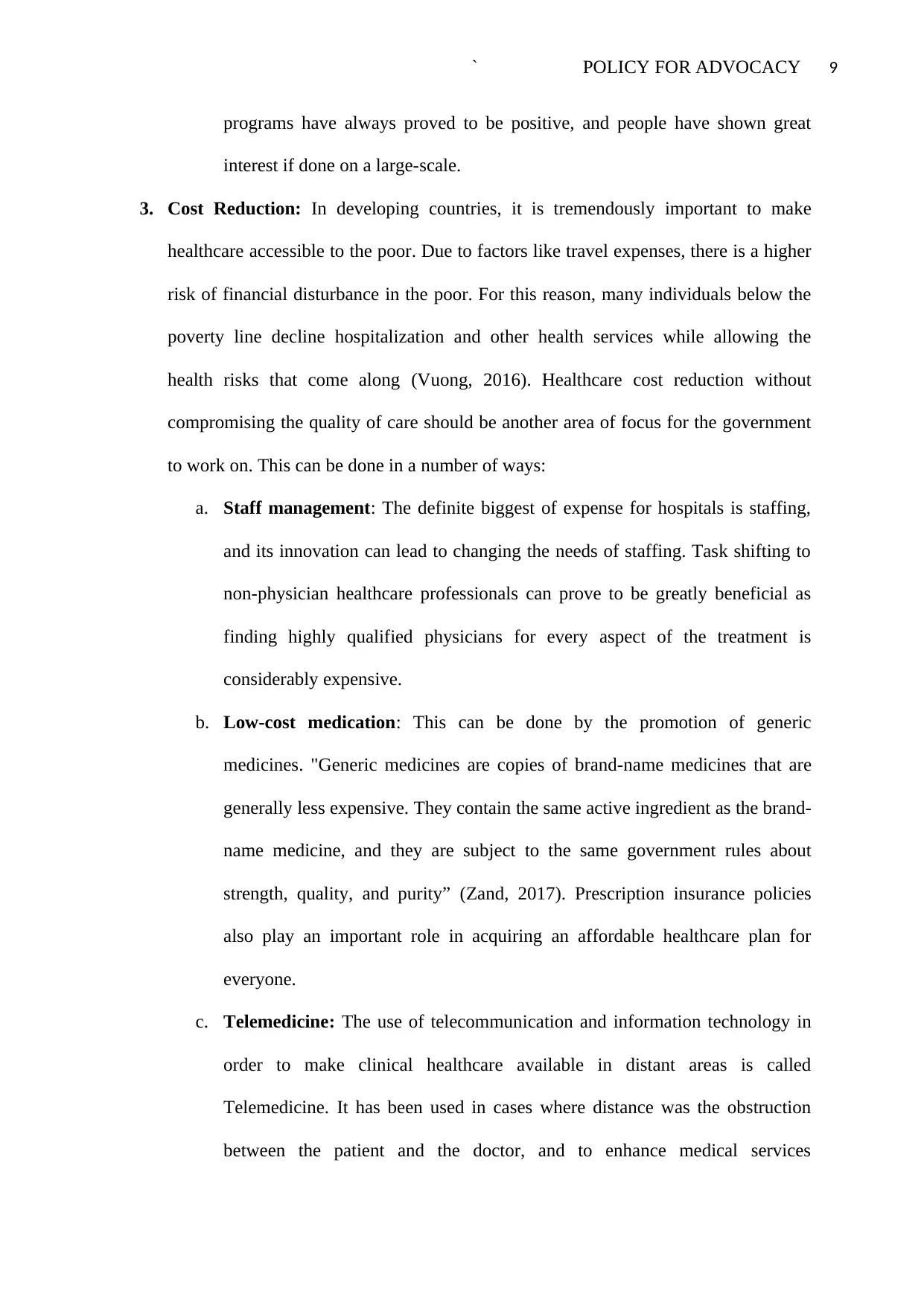
` POLICY FOR ADVOCACY 9
programs have always proved to be positive, and people have shown great
interest if done on a large-scale.
3. Cost Reduction: In developing countries, it is tremendously important to make
healthcare accessible to the poor. Due to factors like travel expenses, there is a higher
risk of financial disturbance in the poor. For this reason, many individuals below the
poverty line decline hospitalization and other health services while allowing the
health risks that come along (Vuong, 2016). Healthcare cost reduction without
compromising the quality of care should be another area of focus for the government
to work on. This can be done in a number of ways:
a. Staff management: The definite biggest of expense for hospitals is staffing,
and its innovation can lead to changing the needs of staffing. Task shifting to
non-physician healthcare professionals can prove to be greatly beneficial as
finding highly qualified physicians for every aspect of the treatment is
considerably expensive.
b. Low-cost medication: This can be done by the promotion of generic
medicines. "Generic medicines are copies of brand-name medicines that are
generally less expensive. They contain the same active ingredient as the brand-
name medicine, and they are subject to the same government rules about
strength, quality, and purity” (Zand, 2017). Prescription insurance policies
also play an important role in acquiring an affordable healthcare plan for
everyone.
c. Telemedicine: The use of telecommunication and information technology in
order to make clinical healthcare available in distant areas is called
Telemedicine. It has been used in cases where distance was the obstruction
between the patient and the doctor, and to enhance medical services
programs have always proved to be positive, and people have shown great
interest if done on a large-scale.
3. Cost Reduction: In developing countries, it is tremendously important to make
healthcare accessible to the poor. Due to factors like travel expenses, there is a higher
risk of financial disturbance in the poor. For this reason, many individuals below the
poverty line decline hospitalization and other health services while allowing the
health risks that come along (Vuong, 2016). Healthcare cost reduction without
compromising the quality of care should be another area of focus for the government
to work on. This can be done in a number of ways:
a. Staff management: The definite biggest of expense for hospitals is staffing,
and its innovation can lead to changing the needs of staffing. Task shifting to
non-physician healthcare professionals can prove to be greatly beneficial as
finding highly qualified physicians for every aspect of the treatment is
considerably expensive.
b. Low-cost medication: This can be done by the promotion of generic
medicines. "Generic medicines are copies of brand-name medicines that are
generally less expensive. They contain the same active ingredient as the brand-
name medicine, and they are subject to the same government rules about
strength, quality, and purity” (Zand, 2017). Prescription insurance policies
also play an important role in acquiring an affordable healthcare plan for
everyone.
c. Telemedicine: The use of telecommunication and information technology in
order to make clinical healthcare available in distant areas is called
Telemedicine. It has been used in cases where distance was the obstruction
between the patient and the doctor, and to enhance medical services
⊘ This is a preview!⊘
Do you want full access?
Subscribe today to unlock all pages.

Trusted by 1+ million students worldwide
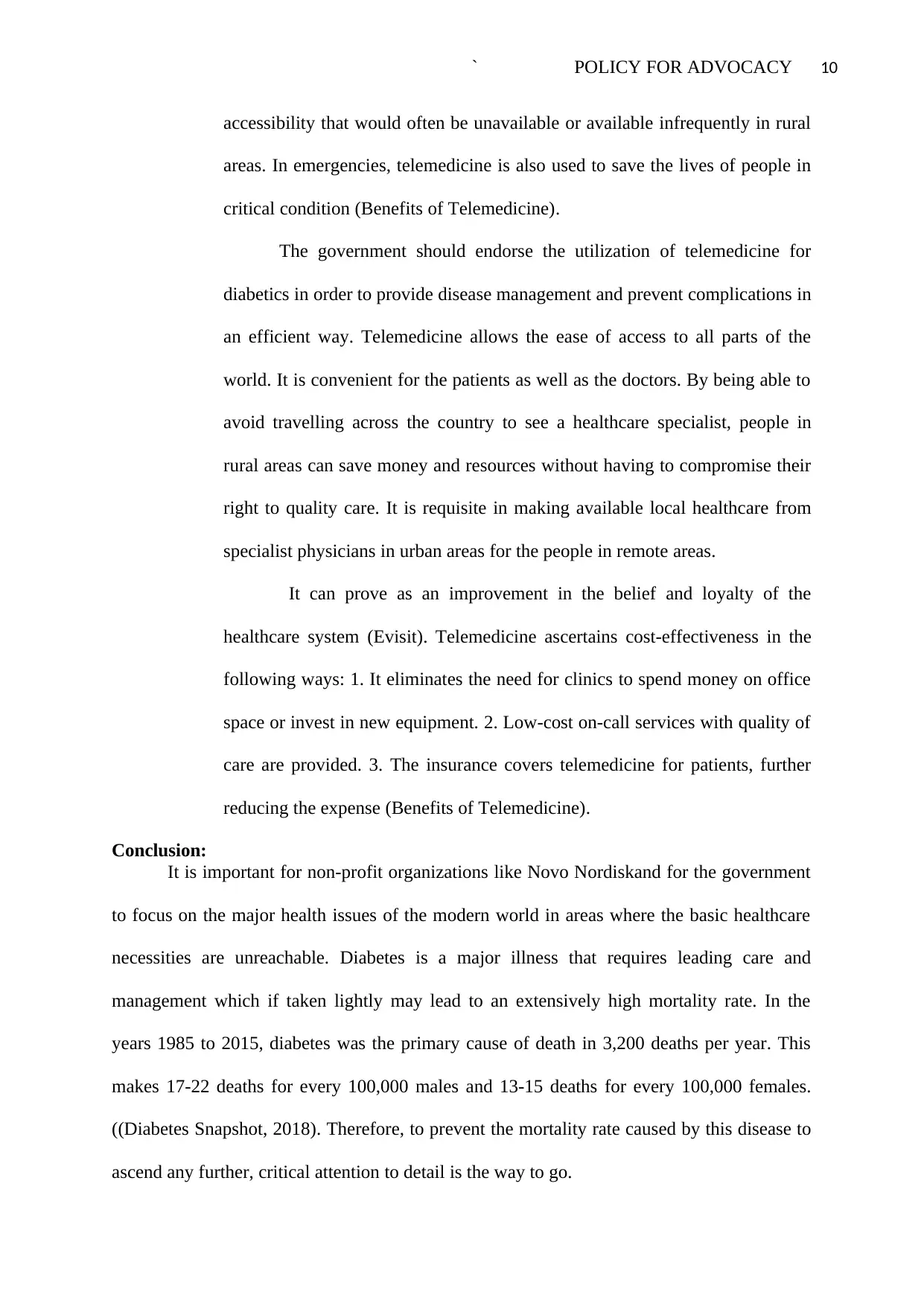
` POLICY FOR ADVOCACY 10
accessibility that would often be unavailable or available infrequently in rural
areas. In emergencies, telemedicine is also used to save the lives of people in
critical condition (Benefits of Telemedicine).
The government should endorse the utilization of telemedicine for
diabetics in order to provide disease management and prevent complications in
an efficient way. Telemedicine allows the ease of access to all parts of the
world. It is convenient for the patients as well as the doctors. By being able to
avoid travelling across the country to see a healthcare specialist, people in
rural areas can save money and resources without having to compromise their
right to quality care. It is requisite in making available local healthcare from
specialist physicians in urban areas for the people in remote areas.
It can prove as an improvement in the belief and loyalty of the
healthcare system (Evisit). Telemedicine ascertains cost-effectiveness in the
following ways: 1. It eliminates the need for clinics to spend money on office
space or invest in new equipment. 2. Low-cost on-call services with quality of
care are provided. 3. The insurance covers telemedicine for patients, further
reducing the expense (Benefits of Telemedicine).
Conclusion:
It is important for non-profit organizations like Novo Nordiskand for the government
to focus on the major health issues of the modern world in areas where the basic healthcare
necessities are unreachable. Diabetes is a major illness that requires leading care and
management which if taken lightly may lead to an extensively high mortality rate. In the
years 1985 to 2015, diabetes was the primary cause of death in 3,200 deaths per year. This
makes 17-22 deaths for every 100,000 males and 13-15 deaths for every 100,000 females.
((Diabetes Snapshot, 2018). Therefore, to prevent the mortality rate caused by this disease to
ascend any further, critical attention to detail is the way to go.
accessibility that would often be unavailable or available infrequently in rural
areas. In emergencies, telemedicine is also used to save the lives of people in
critical condition (Benefits of Telemedicine).
The government should endorse the utilization of telemedicine for
diabetics in order to provide disease management and prevent complications in
an efficient way. Telemedicine allows the ease of access to all parts of the
world. It is convenient for the patients as well as the doctors. By being able to
avoid travelling across the country to see a healthcare specialist, people in
rural areas can save money and resources without having to compromise their
right to quality care. It is requisite in making available local healthcare from
specialist physicians in urban areas for the people in remote areas.
It can prove as an improvement in the belief and loyalty of the
healthcare system (Evisit). Telemedicine ascertains cost-effectiveness in the
following ways: 1. It eliminates the need for clinics to spend money on office
space or invest in new equipment. 2. Low-cost on-call services with quality of
care are provided. 3. The insurance covers telemedicine for patients, further
reducing the expense (Benefits of Telemedicine).
Conclusion:
It is important for non-profit organizations like Novo Nordiskand for the government
to focus on the major health issues of the modern world in areas where the basic healthcare
necessities are unreachable. Diabetes is a major illness that requires leading care and
management which if taken lightly may lead to an extensively high mortality rate. In the
years 1985 to 2015, diabetes was the primary cause of death in 3,200 deaths per year. This
makes 17-22 deaths for every 100,000 males and 13-15 deaths for every 100,000 females.
((Diabetes Snapshot, 2018). Therefore, to prevent the mortality rate caused by this disease to
ascend any further, critical attention to detail is the way to go.
Paraphrase This Document
Need a fresh take? Get an instant paraphrase of this document with our AI Paraphraser
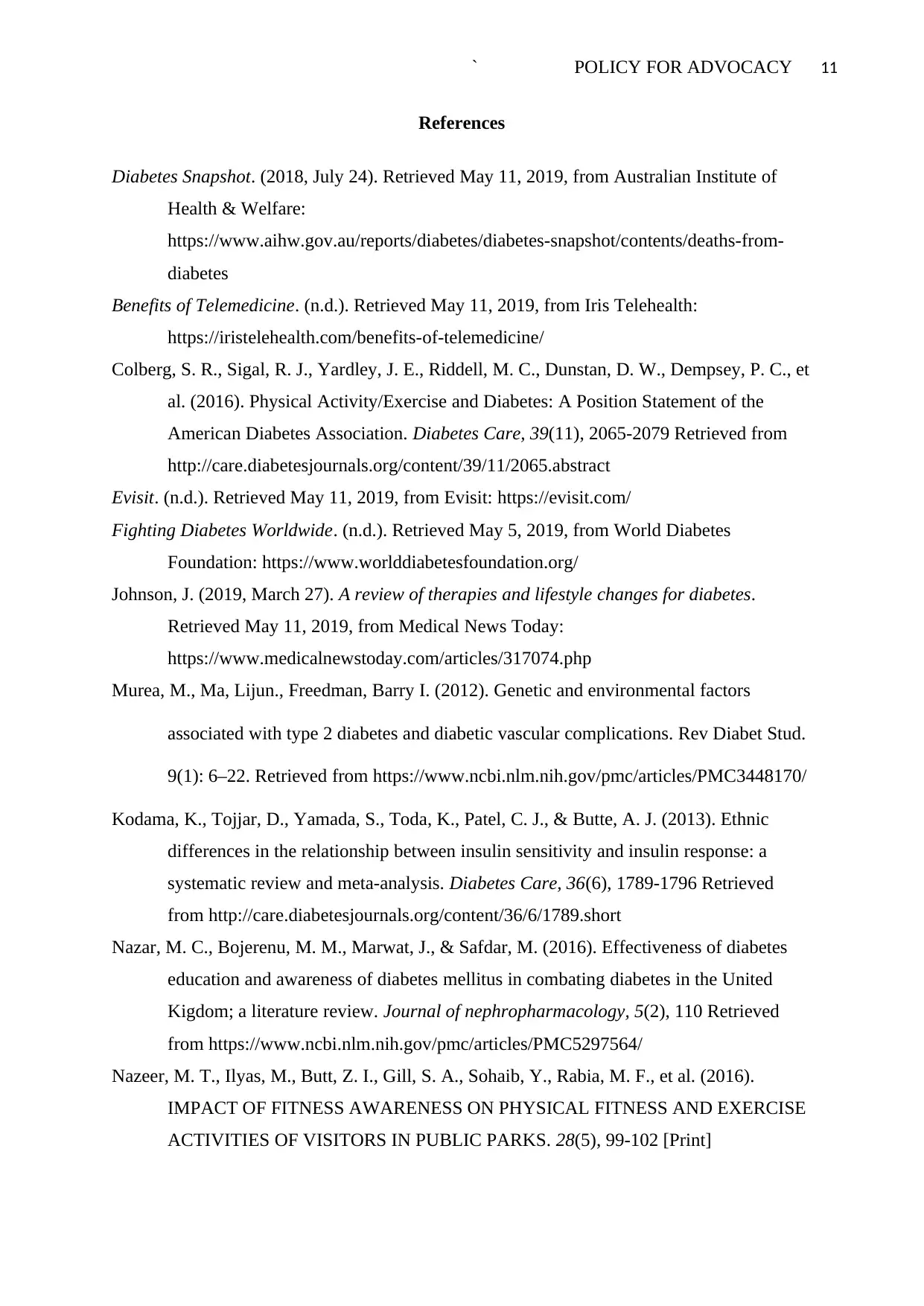
` POLICY FOR ADVOCACY 11
References
Diabetes Snapshot. (2018, July 24). Retrieved May 11, 2019, from Australian Institute of
Health & Welfare:
https://www.aihw.gov.au/reports/diabetes/diabetes-snapshot/contents/deaths-from-
diabetes
Benefits of Telemedicine. (n.d.). Retrieved May 11, 2019, from Iris Telehealth:
https://iristelehealth.com/benefits-of-telemedicine/
Colberg, S. R., Sigal, R. J., Yardley, J. E., Riddell, M. C., Dunstan, D. W., Dempsey, P. C., et
al. (2016). Physical Activity/Exercise and Diabetes: A Position Statement of the
American Diabetes Association. Diabetes Care, 39(11), 2065-2079 Retrieved from
http://care.diabetesjournals.org/content/39/11/2065.abstract
Evisit. (n.d.). Retrieved May 11, 2019, from Evisit: https://evisit.com/
Fighting Diabetes Worldwide. (n.d.). Retrieved May 5, 2019, from World Diabetes
Foundation: https://www.worlddiabetesfoundation.org/
Johnson, J. (2019, March 27). A review of therapies and lifestyle changes for diabetes.
Retrieved May 11, 2019, from Medical News Today:
https://www.medicalnewstoday.com/articles/317074.php
Murea, M., Ma, Lijun., Freedman, Barry I. (2012). Genetic and environmental factors
associated with type 2 diabetes and diabetic vascular complications. Rev Diabet Stud.
9(1): 6–22. Retrieved from https://www.ncbi.nlm.nih.gov/pmc/articles/PMC3448170/
Kodama, K., Tojjar, D., Yamada, S., Toda, K., Patel, C. J., & Butte, A. J. (2013). Ethnic
differences in the relationship between insulin sensitivity and insulin response: a
systematic review and meta-analysis. Diabetes Care, 36(6), 1789-1796 Retrieved
from http://care.diabetesjournals.org/content/36/6/1789.short
Nazar, M. C., Bojerenu, M. M., Marwat, J., & Safdar, M. (2016). Effectiveness of diabetes
education and awareness of diabetes mellitus in combating diabetes in the United
Kigdom; a literature review. Journal of nephropharmacology, 5(2), 110 Retrieved
from https://www.ncbi.nlm.nih.gov/pmc/articles/PMC5297564/
Nazeer, M. T., Ilyas, M., Butt, Z. I., Gill, S. A., Sohaib, Y., Rabia, M. F., et al. (2016).
IMPACT OF FITNESS AWARENESS ON PHYSICAL FITNESS AND EXERCISE
ACTIVITIES OF VISITORS IN PUBLIC PARKS. 28(5), 99-102 [Print]
References
Diabetes Snapshot. (2018, July 24). Retrieved May 11, 2019, from Australian Institute of
Health & Welfare:
https://www.aihw.gov.au/reports/diabetes/diabetes-snapshot/contents/deaths-from-
diabetes
Benefits of Telemedicine. (n.d.). Retrieved May 11, 2019, from Iris Telehealth:
https://iristelehealth.com/benefits-of-telemedicine/
Colberg, S. R., Sigal, R. J., Yardley, J. E., Riddell, M. C., Dunstan, D. W., Dempsey, P. C., et
al. (2016). Physical Activity/Exercise and Diabetes: A Position Statement of the
American Diabetes Association. Diabetes Care, 39(11), 2065-2079 Retrieved from
http://care.diabetesjournals.org/content/39/11/2065.abstract
Evisit. (n.d.). Retrieved May 11, 2019, from Evisit: https://evisit.com/
Fighting Diabetes Worldwide. (n.d.). Retrieved May 5, 2019, from World Diabetes
Foundation: https://www.worlddiabetesfoundation.org/
Johnson, J. (2019, March 27). A review of therapies and lifestyle changes for diabetes.
Retrieved May 11, 2019, from Medical News Today:
https://www.medicalnewstoday.com/articles/317074.php
Murea, M., Ma, Lijun., Freedman, Barry I. (2012). Genetic and environmental factors
associated with type 2 diabetes and diabetic vascular complications. Rev Diabet Stud.
9(1): 6–22. Retrieved from https://www.ncbi.nlm.nih.gov/pmc/articles/PMC3448170/
Kodama, K., Tojjar, D., Yamada, S., Toda, K., Patel, C. J., & Butte, A. J. (2013). Ethnic
differences in the relationship between insulin sensitivity and insulin response: a
systematic review and meta-analysis. Diabetes Care, 36(6), 1789-1796 Retrieved
from http://care.diabetesjournals.org/content/36/6/1789.short
Nazar, M. C., Bojerenu, M. M., Marwat, J., & Safdar, M. (2016). Effectiveness of diabetes
education and awareness of diabetes mellitus in combating diabetes in the United
Kigdom; a literature review. Journal of nephropharmacology, 5(2), 110 Retrieved
from https://www.ncbi.nlm.nih.gov/pmc/articles/PMC5297564/
Nazeer, M. T., Ilyas, M., Butt, Z. I., Gill, S. A., Sohaib, Y., Rabia, M. F., et al. (2016).
IMPACT OF FITNESS AWARENESS ON PHYSICAL FITNESS AND EXERCISE
ACTIVITIES OF VISITORS IN PUBLIC PARKS. 28(5), 99-102 [Print]
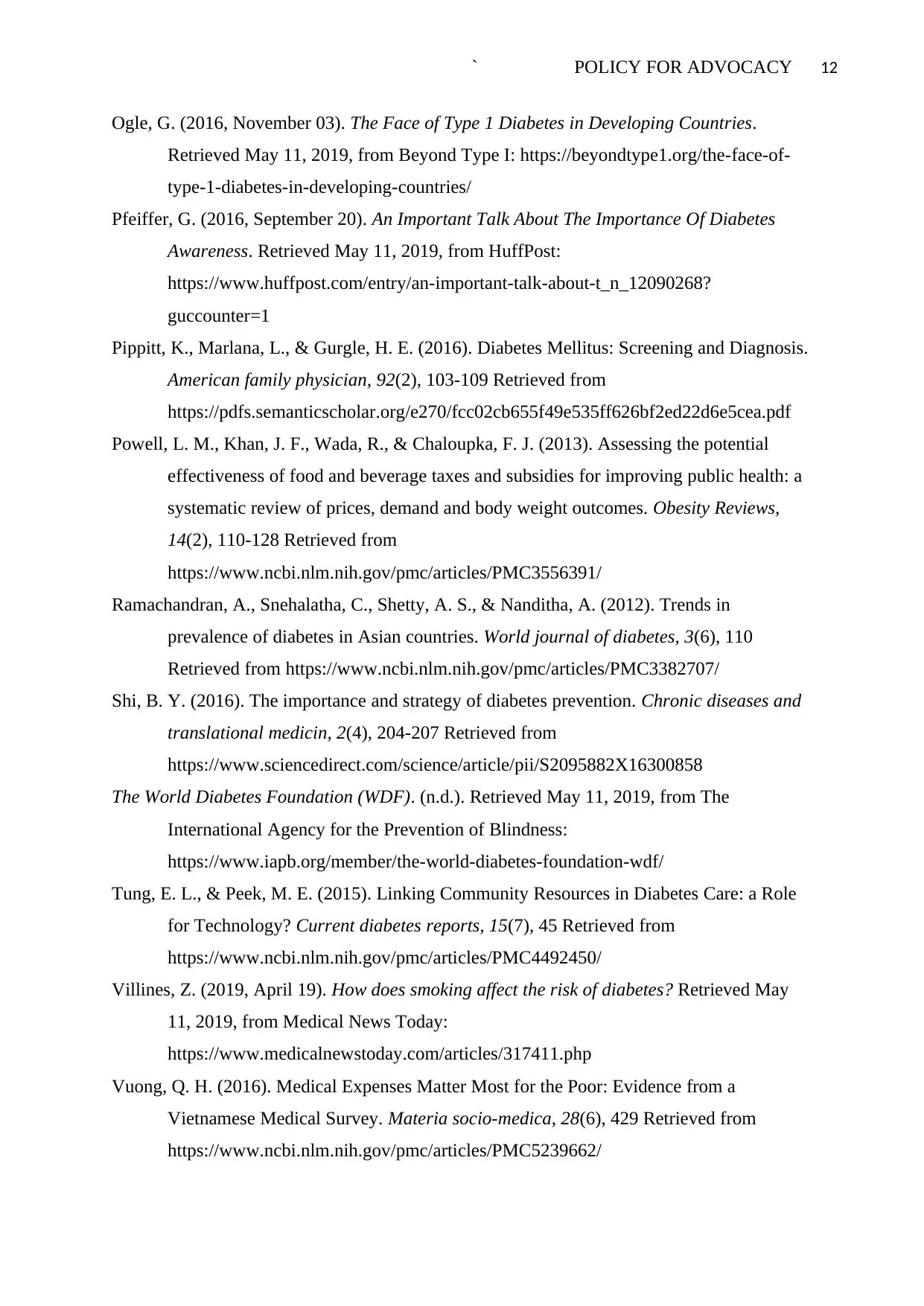
` POLICY FOR ADVOCACY 12
Ogle, G. (2016, November 03). The Face of Type 1 Diabetes in Developing Countries.
Retrieved May 11, 2019, from Beyond Type I: https://beyondtype1.org/the-face-of-
type-1-diabetes-in-developing-countries/
Pfeiffer, G. (2016, September 20). An Important Talk About The Importance Of Diabetes
Awareness. Retrieved May 11, 2019, from HuffPost:
https://www.huffpost.com/entry/an-important-talk-about-t_n_12090268?
guccounter=1
Pippitt, K., Marlana, L., & Gurgle, H. E. (2016). Diabetes Mellitus: Screening and Diagnosis.
American family physician, 92(2), 103-109 Retrieved from
https://pdfs.semanticscholar.org/e270/fcc02cb655f49e535ff626bf2ed22d6e5cea.pdf
Powell, L. M., Khan, J. F., Wada, R., & Chaloupka, F. J. (2013). Assessing the potential
effectiveness of food and beverage taxes and subsidies for improving public health: a
systematic review of prices, demand and body weight outcomes. Obesity Reviews,
14(2), 110-128 Retrieved from
https://www.ncbi.nlm.nih.gov/pmc/articles/PMC3556391/
Ramachandran, A., Snehalatha, C., Shetty, A. S., & Nanditha, A. (2012). Trends in
prevalence of diabetes in Asian countries. World journal of diabetes, 3(6), 110
Retrieved from https://www.ncbi.nlm.nih.gov/pmc/articles/PMC3382707/
Shi, B. Y. (2016). The importance and strategy of diabetes prevention. Chronic diseases and
translational medicin, 2(4), 204-207 Retrieved from
https://www.sciencedirect.com/science/article/pii/S2095882X16300858
The World Diabetes Foundation (WDF). (n.d.). Retrieved May 11, 2019, from The
International Agency for the Prevention of Blindness:
https://www.iapb.org/member/the-world-diabetes-foundation-wdf/
Tung, E. L., & Peek, M. E. (2015). Linking Community Resources in Diabetes Care: a Role
for Technology? Current diabetes reports, 15(7), 45 Retrieved from
https://www.ncbi.nlm.nih.gov/pmc/articles/PMC4492450/
Villines, Z. (2019, April 19). How does smoking affect the risk of diabetes? Retrieved May
11, 2019, from Medical News Today:
https://www.medicalnewstoday.com/articles/317411.php
Vuong, Q. H. (2016). Medical Expenses Matter Most for the Poor: Evidence from a
Vietnamese Medical Survey. Materia socio-medica, 28(6), 429 Retrieved from
https://www.ncbi.nlm.nih.gov/pmc/articles/PMC5239662/
Ogle, G. (2016, November 03). The Face of Type 1 Diabetes in Developing Countries.
Retrieved May 11, 2019, from Beyond Type I: https://beyondtype1.org/the-face-of-
type-1-diabetes-in-developing-countries/
Pfeiffer, G. (2016, September 20). An Important Talk About The Importance Of Diabetes
Awareness. Retrieved May 11, 2019, from HuffPost:
https://www.huffpost.com/entry/an-important-talk-about-t_n_12090268?
guccounter=1
Pippitt, K., Marlana, L., & Gurgle, H. E. (2016). Diabetes Mellitus: Screening and Diagnosis.
American family physician, 92(2), 103-109 Retrieved from
https://pdfs.semanticscholar.org/e270/fcc02cb655f49e535ff626bf2ed22d6e5cea.pdf
Powell, L. M., Khan, J. F., Wada, R., & Chaloupka, F. J. (2013). Assessing the potential
effectiveness of food and beverage taxes and subsidies for improving public health: a
systematic review of prices, demand and body weight outcomes. Obesity Reviews,
14(2), 110-128 Retrieved from
https://www.ncbi.nlm.nih.gov/pmc/articles/PMC3556391/
Ramachandran, A., Snehalatha, C., Shetty, A. S., & Nanditha, A. (2012). Trends in
prevalence of diabetes in Asian countries. World journal of diabetes, 3(6), 110
Retrieved from https://www.ncbi.nlm.nih.gov/pmc/articles/PMC3382707/
Shi, B. Y. (2016). The importance and strategy of diabetes prevention. Chronic diseases and
translational medicin, 2(4), 204-207 Retrieved from
https://www.sciencedirect.com/science/article/pii/S2095882X16300858
The World Diabetes Foundation (WDF). (n.d.). Retrieved May 11, 2019, from The
International Agency for the Prevention of Blindness:
https://www.iapb.org/member/the-world-diabetes-foundation-wdf/
Tung, E. L., & Peek, M. E. (2015). Linking Community Resources in Diabetes Care: a Role
for Technology? Current diabetes reports, 15(7), 45 Retrieved from
https://www.ncbi.nlm.nih.gov/pmc/articles/PMC4492450/
Villines, Z. (2019, April 19). How does smoking affect the risk of diabetes? Retrieved May
11, 2019, from Medical News Today:
https://www.medicalnewstoday.com/articles/317411.php
Vuong, Q. H. (2016). Medical Expenses Matter Most for the Poor: Evidence from a
Vietnamese Medical Survey. Materia socio-medica, 28(6), 429 Retrieved from
https://www.ncbi.nlm.nih.gov/pmc/articles/PMC5239662/
⊘ This is a preview!⊘
Do you want full access?
Subscribe today to unlock all pages.

Trusted by 1+ million students worldwide
1 out of 13
Related Documents
Your All-in-One AI-Powered Toolkit for Academic Success.
+13062052269
info@desklib.com
Available 24*7 on WhatsApp / Email
![[object Object]](/_next/static/media/star-bottom.7253800d.svg)
Unlock your academic potential
Copyright © 2020–2025 A2Z Services. All Rights Reserved. Developed and managed by ZUCOL.





